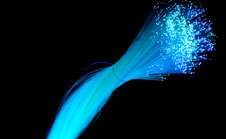Scientists twist light to send data

(Phys.org) -- A multi-national team led by USC with researchers hailing from the U.S., China, Pakistan and Israel has developed a system of transmitting data using twisted beams of light at ultra-high speeds – up to 2.56 terabits per second.
To put that in perspective, broadband cable (which you probably used to download this) supports up to about 30 megabits per second. The twisted-light system transmits more than 85,000 times more data per second.
Their work might be used to build high-speed satellite communication links, short free-space terrestrial links, or potentially be adapted for use in the fiber optic cables that are used by some Internet service providers.
"You're able to do things with light that you can't do with electricity," said Alan Willner, electrical engineering professor at the USC Viterbi School of Engineering and the corresponding author of an article about the research that was published in Nature Photonics on June 24. "That's the beauty of light; it's a bunch of photons that can be manipulated in many different ways at very high speed."
Willner and his colleagues used beam-twisting "phase holograms" to manipulate eight beams of light so that each one twisted in a DNA-like helical shape as it propagated in free space. Each of the beams had its own individual twist and can be encoded with "1" and "0" data bits, making each an independent data stream – much like separate channels on your radio.
Their demonstration transmitted the data over open space in a lab, attempting to simulate the sort of communications that might occur between satellites in space. Among the next steps for the research field will be to advance how it could be adapted for use in fiber optics, like those frequently used to transmit data over the Internet.
The team's work builds on research done by Leslie Allen, Anton Zeilinger, Miles Padgett and their colleagues at several European universities.
"We didn't invent the twisting of light, but we took the concept and ramped it up to a terabit-per-second," Willner said. His team included Jian Wang, Jeng-Yuan Yang, Irfan M. Fazal, Nisar Ahmed, Yan Yan, Hao Huang, Yongxiong Ren and Yang Yue from USC; Samuel Dolinar from NASA's Jet Propulsion Laboratory; and Moshe Tur from Tel Aviv University.
Wang, the lead author, left USC after completing this research and is now a professor at the Huazhong University of Science and Technology in China.
More information: www.nature.com/nphoton/journal … photon.2012.138.html
Journal information: Nature Photonics
Provided by University of Southern California
















